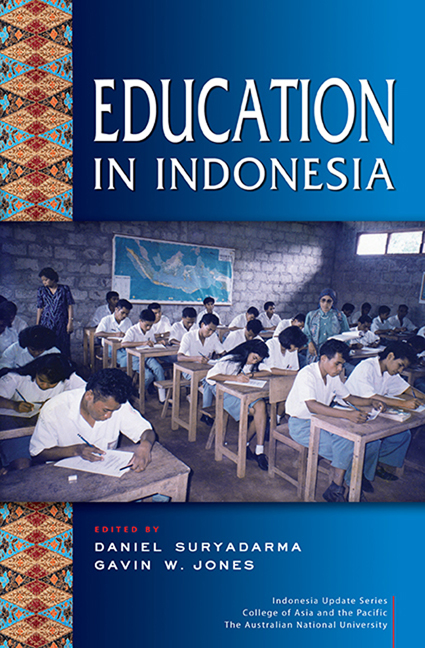Book contents
- Frontmatter
- Contents
- Tables
- Figures
- Contributors
- Acknowledgments
- Glossary
- 1 Meeting the Education Challenge
- 2 Trends in Education in Indonesia
- 3 Teacher Training, School Norms and Teacher Effectiveness in Indonesia
- 4 Integrating Islamic Schools into the Indonesian National Education System: A Case of Architecture over Implementation?
- 5 Early Childhood Education and Development Services in Indonesia
- 6 Where Did All the Money Go? Financing Basic Education in Indonesia
- 7 An Assessment of Policies to Improve Teacher Quality and Reduce Teacher Absenteeism
- 8 Indonesian Universities: Rapid Growth, Major Challenges
- 9 Beating the Odds: Locally Relevant Alternatives to World-class Universities
- 10 Financing Higher Education: The Viability of a Commercial Student Loan Scheme in Indonesia
- 11 The Transformation and Internationalization of Higher Education: The Malaysian Experience
- 12 Role of the Education and Training Sector in Addressing Skill Mismatch in Indonesia
- Index
- Indonesia Update Series
8 - Indonesian Universities: Rapid Growth, Major Challenges
Published online by Cambridge University Press: 21 October 2015
- Frontmatter
- Contents
- Tables
- Figures
- Contributors
- Acknowledgments
- Glossary
- 1 Meeting the Education Challenge
- 2 Trends in Education in Indonesia
- 3 Teacher Training, School Norms and Teacher Effectiveness in Indonesia
- 4 Integrating Islamic Schools into the Indonesian National Education System: A Case of Architecture over Implementation?
- 5 Early Childhood Education and Development Services in Indonesia
- 6 Where Did All the Money Go? Financing Basic Education in Indonesia
- 7 An Assessment of Policies to Improve Teacher Quality and Reduce Teacher Absenteeism
- 8 Indonesian Universities: Rapid Growth, Major Challenges
- 9 Beating the Odds: Locally Relevant Alternatives to World-class Universities
- 10 Financing Higher Education: The Viability of a Commercial Student Loan Scheme in Indonesia
- 11 The Transformation and Internationalization of Higher Education: The Malaysian Experience
- 12 Role of the Education and Training Sector in Addressing Skill Mismatch in Indonesia
- Index
- Indonesia Update Series
Summary
INTRODUCTION
As befits its size and rising income, Indonesia now has one of the largest and fastest-growing tertiary education systems in the world. In 2010, about 5.2 million students were enrolled in some sort of institute of higher education, including universities, academies, polytechnics and advanced schools (sekolah tinggi), with almost three times as many enrolled in private as in public institutions. These students were enrolled in about 3,600 institutions administered mainly by the Ministry of Education and Culture and the Ministry of Religious Affairs. he focus of this chapter is on the country's approximately 550 universities, which attract most of the public funding, and which are seen as the major vehicle for lifting the standard of knowhow and intellectual discourse, and for providing high-level policy advice to government.
We commence by making five broad generalizations about these institutions. First, Indonesian universities are essentially a creation of the second half of the twentieth century, with most of the growth occurring in the last quarter of that century. For all practical purposes, Indonesia barely possessed a tertiary education sector in the colonial era; during the first two decades of independence the growth of the sector was constrained by other nation-building priorities, including the necessity to expand primary and secondary education, and by the country's indifferent economic performance.
Second, as a result of this history, the country has been an educational laggard, consistently ranking behind the Asian giants, China and India, and behind its middle-income ASEAN neighbours. Educational disadvantage typically takes decades to overcome, even with very high levels of expenditure and commitment, neither of which Indonesia has in abundant proportions.
A third feature is that the sector began to grow very rapidly from the 1980s, driven by several factors. One was the large cohort beginning to graduate from the country's primary and secondary schools as a result of the commitment to universal education at these levels. Another was that the country was by then about to graduate into the ranks of lower middle-income developing countries, crossing a threshold where the demand for higher education would become highly income-elastic, and the labour market more ‘credentialed’ in the sense of requiring more formal professional qualifications, and demanding a more skilled workforce. Moreover, the private tertiary education sector began to grow quickly, and was by then operating in a somewhat less restrictive regulatory regime.
- Type
- Chapter
- Information
- Education in Indonesia , pp. 160 - 179Publisher: ISEAS–Yusof Ishak InstitutePrint publication year: 2013

